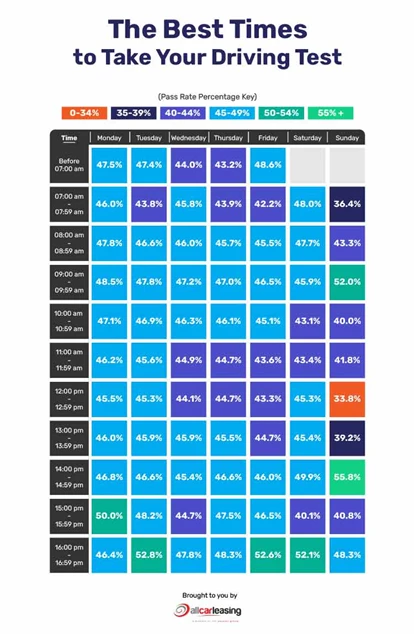Many would agree that starting a new journey on a rainy Monday morning can be quite challenging. Now, imagine the added anxiety of a driving test scheduled during heavy downpour and rush hour. Such timing is bound to spike nervousness and potentially impact driving performance.
Statistically, the failure rates for driving tests tend to be higher during peak traffic periods and adverse weather conditions. Historically, early winter mornings, when roads are icy, pose additional hazards for novice drivers. Recognizing these patterns can help both instructors and learners strategize better timing for their tests, leading to more favorable outcomes.

What’s the Worst Time to Have a Driving Test?
Taking a driving test can be stressful, but some times might make it even harder. Rush hour, for example, can be extremely challenging. Heavy traffic and impatient drivers can add extra pressure. It’s difficult to navigate busy streets and make quick decisions. Your nerves might get the best of you.
Another tough time for a driving test is during severe weather. Rain, snow, or fog can reduce visibility and make roads slippery. This increases the risk of mistakes and even accidents. Drivers need to be extra cautious, which could lead to hesitation and errors during the test. Severe weather conditions definitely add another layer of difficulty.
Early morning tests, especially during winter, can also be problematic. Roads might be icy, making driving more dangerous. Additionally, the sun might be low in the sky, causing glare that can hinder visibility. Sleepy drivers can feel less alert and more prone to errors. All these factors can make passing a driving test in the morning more challenging.
Choosing a driving test time during school pickup hours can be tricky. The roads around schools are usually packed with cars and pedestrians. Kids can suddenly cross the street, causing unexpected stops. The extra traffic can be stressful. It’s best to avoid scheduling your driving test during these times.
Key Factors That Influence Driving Test Difficulty
Weather plays a significant role in making a driving test more difficult. Rain can create slippery roads, while fog can limit visibility. Snow adds another layer of challenge by making the road conditions unpredictable. These elements demand extra caution. It forces test-takers to adapt quickly to changing conditions.
Traffic conditions also heavily influence the difficulty of a driving test. During rush hours, the roads are packed with vehicles, making it hard to focus. Aggressive drivers and unexpected stops increase stress levels. Navigating through busy streets requires sharp skills. Test-takers can feel overwhelmed under these circumstances.
The time of day can affect driving test performance too. Early morning tests might mean dealing with fog or frost. Late afternoon tests can involve glaring sunlight. Both of these conditions can reduce visibility. They make it harder to see road signs and other vehicles. Choosing a time when the sun is not too bright can be beneficial.
The location of the test center is another key factor. Urban areas usually have heavy traffic and complex road systems. Rural areas might have fewer cars but more challenging terrains. City driving requires dealing with pedestrians and cyclists. Each location presents unique challenges. It’s important to practice in similar environments.
Impact of Weather Conditions on Driving Tests
Weather conditions can greatly impact the difficulty of a driving test. Rain, for example, makes the roads slippery, which can lead to skidding. Puddles can cause hydroplaning, where the car slides uncontrollably. Rain also reduces visibility, making it harder to see other vehicles and road signs. All these factors increase the stress and challenge for test-takers.
Snow presents an entirely different set of challenges for driving tests. Snow-covered roads can hide markings and make it difficult to judge distances. Ice patches can cause unexpected skids, even at low speeds. Maneuvering through snow requires careful handling and slower speeds. This can make even simple tasks like parking more complicated.
Fog is another weather condition that can complicate a driving test. Fog reduces visibility, making it hard to see ahead or spot obstacles. Driver’s reaction time can be slower as they are extra cautious. In foggy conditions, headlights might reflect off the mist, creating glare and further reducing vision. This can make it challenging to navigate turns and intersections.
Wind can be an overlooked but impactful weather condition during a driving test. Strong winds can blow debris onto the road, creating unexpected hazards. High winds can also push the car sideways, especially on bridges or open roads. This requires constant adjustment of the steering wheel to stay in the lane. It’s an added challenge that test-takers must handle carefully.
How Traffic Congestion Affects Driving Tests
Traffic congestion can significantly impact driving tests by increasing stress levels. When roads are packed with vehicles, drivers have less room to maneuver. This can make it challenging to change lanes or turn. The constant stop-and-go movement can also be frustrating. For test-takers, this adds extra pressure to perform well.
Heavy traffic often results in longer stopping times and frequent braking. This can affect the rhythm of a driving test and disrupt concentration. It’s harder to maintain steady speeds and smooth driving under these conditions. Unexpected stops and starts increase the likelihood of errors. These factors can reduce a test-taker’s confidence.
Navigation in high-traffic areas often involves more complex decisions. Drivers may need to weave through multiple lanes or deal with aggressive drivers. These situations require quick thinking and swift reactions. Test-takers must stay calm and focused. Making a wrong move can lead to immediate test failure.
Rush hour traffic, in particular, poses unique challenges. The roads are filled with commuters in a hurry, increasing the risk of accidents. Merging onto busy highways becomes more difficult. The high volume of vehicles can make it tough to find safe gaps. This makes decision-making even more critical.
Traffic congestion can also lengthen the duration of the driving test. More time spent on the road increases the chances of encountering challenging scenarios. The longer the test, the more opportunities for mistakes. For some, this prolonged exposure can heighten anxiety. It requires sustained focus and stamina.
Moreover, traffic patterns are unpredictable. What seems like a light traffic day could quickly change. Accidents, road work, or sudden weather changes can all play a part. This unpredictability makes it hard to prepare adequately. Test-takers need to be ready for anything.
Conclusion
In conclusion, various factors contribute to the difficulty of driving tests, each presenting unique challenges. Weather conditions, traffic congestion, and the time of day all play significant roles. Understanding these elements can help candidates better prepare and choose the best time for their tests.
It’s crucial to be aware of these challenges to improve the chances of passing the test. Selecting optimal conditions can make a substantial difference. Proper preparation and strategic planning are key to achieving success on a driving test.

